Evaluating Spatiotemporal Patterns of Post-Eruption Vegetation Recovery at Unzen Volcano, Japan, from Landsat Time Series
Abstract
1. Introduction
2. Materials and Methods
2.1. Study Site
2.2. Landsat Data and Pre-Processing
2.3. Deriving Explanatory Variables of Vegetation Recovery
| Explanatory Variables | Value Range | Data Source |
|---|---|---|
| Disturbance type | Dead trees, lahar deposits, ash cloud surges, seared zones, block and ash flows, lava dome | [47] |
| Distance from surviving vegetation | 0.0–775.6 m | [47,64] |
| Distance from crater | 0.0–7013.0 m | [47] |
| Slope gradient | 0.1–69.0° | GSI Resampled 30-m DEM |
| Elevation | 6.7–1461.1 m | GSI Resampled 30-m DEM |
| Aspect | N, NE, E, SE, S, SW, W, NW | GSI Resampled 30-m DEM |
| Profile curvature | −0.045–0.042 | GSI Resampled 30-m DEM |
| Disturbance Type | Pixel Count | Area (% of Total) | Definition |
|---|---|---|---|
| Dead trees | 4563 | 20.32 | Areas of standing dead trees killed by volcanic gas and ash cloud |
| Lahar deposits | 3389 | 15.10 | Pyroclastic flow deposits that had been reworked and eroded |
| Ash cloud surges | 1673 | 7.45 | Areas covered by ash cloud deposits and blown-down trees |
| Seared zones | 4281 | 19.10 | Areas seared by ash clouds |
| Block and ash flows | 7963 | 35.45 | Areas directly impacted by the pyroclastic flow |
| Lava dome | 591 | 2.63 | Area of lava dome formation |
| Total area | 22,560 | 100 |
2.4. Computing and Comparing NDVI and NBR
2.5. Deriving Vegetation Recovery Trends and Metrics
2.6. Regression Tree and Correlation Analyses
3. Results
3.1. NDVI and NBR Spectral Responses
3.2. NBR Temporal Recovery Trends
3.3. Spatial Variation of NBR-Derived Recovery Metrics
3.4. Correlation Analysis and Regression Tree Results
4. Discussion
5. Conclusions
Author Contributions
Funding
Data Availability Statement
Conflicts of Interest
References
- Istanbulluoglu, E. Vegetation-Modulated Landscape Evolution: Effects of Vegetation on Landscape Processes, Drainage Density, and Topography. J. Geophys. Res. 2005, 110, F02012. [Google Scholar] [CrossRef]
- Brantley, S.L.; Eissenstat, D.M.; Marshall, J.A.; Godsey, S.E.; Balogh-Brunstad, Z.; Karwan, D.L.; Papuga, S.A.; Roering, J.; Dawson, T.E.; Evaristo, J.; et al. Reviews and Syntheses: On the Roles Trees Play in Building and Plumbing the Critical Zone. Biogeosciences 2017, 14, 5115–5142. [Google Scholar] [CrossRef]
- Amundson, R.; Heimsath, A.; Owen, J.; Yoo, K.; Dietrich, W.E. Hillslope Soils and Vegetation. Geomorphology 2015, 234, 122–132. [Google Scholar] [CrossRef]
- Collins, D.B.G.; Bras, R.L. Climatic and Ecological Controls of Equilibrium Drainage Density, Relief, and Channel Concavity in Dry Lands. Water Resour. Res. 2010, 46. [Google Scholar] [CrossRef]
- Klaar, M.J.; Kidd, C.; Malone, E.; Bartlett, R.; Pinay, G.; Chapin, F.S.; Milner, A. Vegetation Succession in Deglaciated Landscapes: Implications for Sediment and Landscape Stability. Earth Surf. Process. Landf. 2015, 40, 1088–1100. [Google Scholar] [CrossRef]
- Schwarz, C.; Gourgue, O.; van Belzen, J.; Zhu, Z.; Bouma, T.J.; van de Koppel, J.; Ruessink, G.; Claude, N.; Temmerman, S. Self-Organization of a Biogeomorphic Landscape Controlled by Plant Life-History Traits. Nat. Geosci. 2018, 11, 672–677. [Google Scholar] [CrossRef]
- Marston, R.A. Geomorphology and Vegetation on Hillslopes: Interactions, Dependencies, and Feedback Loops. Geomorphology 2010, 116, 206–217. [Google Scholar] [CrossRef]
- Del Moral, R.; Grishin, S.Y. Volcanic Disturbances and Ecosystem Recovery. In Ecosystems of Disturbance Ground; Walker, L.R., Ed.; Elsevier Science: Amsterdam, The Netherlands, 1999; pp. 137–160. ISBN 978-0-08-055084-8. [Google Scholar]
- Pelletier, J.D.; Brad Murray, A.; Pierce, J.L.; Bierman, P.R.; Breshears, D.D.; Crosby, B.T.; Ellis, M.; Foufoula-Georgiou, E.; Heimsath, A.M.; Houser, C.; et al. Forecasting the Response of Earth’s Surface to Future Climatic and Land Use Changes: A Review of Methods and Research Needs. Earth’s Future 2015, 3, 220–251. [Google Scholar] [CrossRef]
- Viles, H.A.; Naylor, L.A.; Carter, N.E.A.; Chaput, D. Biogeomorphological Disturbance Regimes: Progress in Linking Ecological and Geomorphological Systems. Earth Surf. Process. Landf. 2008, 33, 1419–1435. [Google Scholar] [CrossRef]
- Rice, S.; Stoffel, M.; Turowski, J.M.; Wolf, A. Disturbance Regimes at the Interface of Geomorphology and Ecology. Earth Surf. Process. Landf. 2012, 37, 1678–1682. [Google Scholar] [CrossRef]
- Hales, T.C.; Ford, C.R.; Hwang, T.; Vose, J.M.; Band, L.E. Topographic and Ecologic Controls on Root Reinforcement. J. Geophys. Res. 2009, 114, F03013. [Google Scholar] [CrossRef]
- Hales, T.C. Modelling Biome-Scale Root Reinforcement and Slope Stability: Biome Driven Root Reinforcement Change. Earth Surf. Process. Landf. 2018, 43, 2157–2166. [Google Scholar] [CrossRef]
- Yunus, A.P.; Fan, X.; Tang, X.; Jie, D.; Xu, Q.; Huang, R. Decadal Vegetation Succession from MODIS Reveals the Spatio-Temporal Evolution of Post-Seismic Landsliding after the 2008 Wenchuan Earthquake. Remote Sens. Environ. 2020, 236, 111476. [Google Scholar] [CrossRef]
- Raab, T.; Krümmelbein, J.; Schneider, A.; Gerwin, W.; Maurer, T.; Naeth, M.A. Initial Ecosystem Processes as Key Factors of Landscape Development—A Review. Phys. Geogr. 2012, 33, 305–343. [Google Scholar] [CrossRef]
- Crisafulli, C.M.; Dale, V.H. (Eds.) Ecological Response to the 1980 Eruption of Mount St. Helens: Key Lessons and Remaining Questions. In Ecological Responses at Mount St. Helens: Revisited 35 Years after the 1980 Eruption; Springer: New York, NY, USA, 2018; pp. 1–18. ISBN 978-1-4939-7449-8. [Google Scholar]
- Dale, V.H.; Delgado-Acevedo, J.; MacMahon, J. Effects of Modern Volcanic Eruptions on Vegetation. In Volcanoes and the Environment; Marti, J., Ernst, G.G.J., Eds.; Cambridge University Press: Cambridge, UK, 2005; pp. 227–249. ISBN 978-0-521-59725-8. [Google Scholar]
- Tsuyuzaki, S. Vegetation Changes from 1984 to 2008 on Mount Usu, Northern Japan, after the 1977–1978 Eruptions. Ecol. Res. 2019, 34, 813–820. [Google Scholar] [CrossRef]
- De Rose, R.C.; Oguchi, T.; Morishima, W.; Collado, M. Land Cover Change on Mt. Pinatubo, the Philippines, Monitored Using ASTER VNIR. Int. J. Remote Sens. 2011, 32, 9279–9305. [Google Scholar] [CrossRef]
- Chinen, T.; Riviere, A. Post-Eruption Plant Recovery with Reference to Geomorphic Processes in the Summit Atrio of Mt. Usu, Japan. Geogr. Rev. Jpn. Ser. B 1989, 62, 35–55. [Google Scholar] [CrossRef][Green Version]
- Ogawa, Y.; Daimaru, H.; Chikashige, T. Hillside Restoration and Sediment Discharge after the 1990–1995 Eruption at Unzen Volcano, Japan. Water Sci. 2010, 54, 101–124. [Google Scholar] [CrossRef]
- Tsuyuzaki, S. Vegetation Recovery Patterns in Early Volcanic Succession. J. Plant Res. 1995, 108, 241–248. [Google Scholar] [CrossRef]
- Lawrence, R.L.; Ripple, W.J. Fifteen years of revegetation of Mount St. Helens: A landscape-scale analysis. Ecology 2000, 81, 2742–2752. [Google Scholar] [CrossRef]
- Teltscher, K.; Fassnacht, F.E. Using Multispectral Landsat and Sentinel-2 Satellite Data to Investigate Vegetation Change at Mount St. Helens since the Great Volcanic Eruption in 1980. J. Mt. Sci. 2018, 15, 1851–1867. [Google Scholar] [CrossRef]
- Solans Vila, J.P.; Barbosa, P. Post-Fire Vegetation Regrowth Detection in the Deiva Marina Region (Liguria-Italy) Using Landsat TM and ETM+ Data. Ecol. Model. 2010, 221, 75–84. [Google Scholar] [CrossRef]
- Baret, F.; Clevers, J.G.P.W.; Steven, M.D. The Robustness of Canopy Gap Fraction Estimates from Red and Near-Infrared Reflectances: A Comparison of Approaches. Remote Sens. Environ. 1995, 54, 141–151. [Google Scholar] [CrossRef]
- Veraverbeke, S.; Gitas, I.; Katagis, T.; Polychronaki, A.; Somers, B.; Goossens, R. Assessing Post-Fire Vegetation Recovery Using Red–near Infrared Vegetation Indices: Accounting for Background and Vegetation Variability. ISPRS J. Photogramm. Remote Sens. 2012, 68, 28–39. [Google Scholar] [CrossRef]
- Montandon, L.; Small, E. The Impact of Soil Reflectance on the Quantification of the Green Vegetation Fraction from NDVI. Remote Sens. Environ. 2008, 112, 1835–1845. [Google Scholar] [CrossRef]
- Ullah, S.; Si, Y.; Schlerf, M.; Skidmore, A.K.; Shafique, M.; Iqbal, I.A. Estimation of Grassland Biomass and Nitrogen Using MERIS Data. Int. J. Appl. Earth Obs. Geoinf. 2012, 19, 196–204. [Google Scholar] [CrossRef]
- Smith, A.M.S.; Eitel, J.U.H.; Hudak, A.T. Spectral Analysis of Charcoal on Soils: Implicationsfor Wildland Fire Severity Mapping Methods. Int. J. Wildland Fire 2010, 19, 976–983. [Google Scholar] [CrossRef]
- Decuyper, M.; Chávez, R.O.; Čufar, K.; Estay, S.A.; Clevers, J.G.P.W.; Prislan, P.; Gričar, J.; Črepinšek, Z.; Merela, M.; de Luis, M.; et al. Spatio-Temporal Assessment of Beech Growth in Relation to Climate Extremes in Slovenia—An Integrated Approach Using Remote Sensing and Tree-Ring Data. Agric. For. Meteorol. 2020, 287, 107925. [Google Scholar] [CrossRef]
- Wulder, M. Optical Remote-Sensing Techniques for the Assessment of Forest Inventory and Biophysical Parameters. Prog. Phys. Geogr. 1998, 22, 449–476. [Google Scholar] [CrossRef]
- Pickell, P.D.; Hermosilla, T.; Frazier, R.J.; Coops, N.C.; Wulder, M.A. Forest Recovery Trends Derived from Landsat Time Series for North American Boreal Forests. Int. J. Remote Sens. 2016, 37, 138–149. [Google Scholar] [CrossRef]
- Tucker, C.J. Red and Photographic Infrared Linear Combinations for Monitoring Vegetation. Remote Sens. Environ. 1979, 8, 127–150. [Google Scholar] [CrossRef]
- Key, C.H.; Benson, N.C. Landscape Assessment: Ground Measure of Severity, the Composite Burn Index; and Remote Sensing of Severity, the Normalized Burn Ratio; FIREMON: Fire Effects Monitoring and Inventory System; USDA Forest Service, Rocky Mountain Research Station: Ogden, UT, USA, 2006; pp. LA1–LA51. [Google Scholar]
- Purevdorj, T.S.; Tateishi, R.; Ishiyama, T.; Honda, Y. Relationships between Percent Vegetation Cover and Vegetation Indices. Int. J. Remote Sens. 1998, 19, 3519–3535. [Google Scholar] [CrossRef]
- Díaz-Delgado, R.; Salvador, R.; Pons, X. Monitoring of Plant Community Regeneration after Fire by Remote Sensing. In Fire Management and Landscape Ecology; International Association of Wildland Fire: Missoula, MT, USA, 1998; pp. 315–324. [Google Scholar]
- Prabhakara, K.; Hively, W.D.; McCarty, G.W. Evaluating the Relationship between Biomass, Percent Groundcover and Remote Sensing Indices across Six Winter Cover Crop Fields in Maryland, United States. Int. J. Appl. Earth Obs. Geoinf. 2015, 39, 88–102. [Google Scholar] [CrossRef]
- Carlson, T.N.; Ripley, D.A. On the Relation between NDVI, Fractional Vegetation Cover, and Leaf Area Index. Remote Sens. Environ. 1997, 62, 241–252. [Google Scholar] [CrossRef]
- White, J.C.; Wulder, M.A.; Hermosilla, T.; Coops, N.C.; Hobart, G.W. A Nationwide Annual Characterization of 25 Years of Forest Disturbance and Recovery for Canada Using Landsat Time Series. Remote Sens. Environ. 2017, 194, 303–321. [Google Scholar] [CrossRef]
- Frazier, R.J.; Coops, N.C.; Wulder, M.A.; Hermosilla, T.; White, J.C. Analyzing Spatial and Temporal Variability in Short-Term Rates of Post-Fire Vegetation Return from Landsat Time Series. Remote Sens. Environ. 2018, 205, 32–45. [Google Scholar] [CrossRef]
- Kottek, M.; Grieser, J.; Beck, C.; Rudolf, B.; Rubel, F. World Map of the Köppen-Geiger Climate Classification Updated. Meteorol. Z. 2006, 15, 259–263. [Google Scholar] [CrossRef]
- Kawamoto, K.; Maeda, H.; Soeyama, H. The State of Vegetation around Runout Zone of Pyroclastic Flow at Mt. Fugen in Unzen. Kyushu J. For. Res. 2010, 63, 185–186. [Google Scholar]
- Nakada, S.; Shimizu, H.; Ohta, K. Overview of the 1990–1995 Eruption at Unzen Volcano. J. Volcanol. Geotherm. Res. 1999, 89, 1–22. [Google Scholar] [CrossRef]
- Hoshizumi, H.; Uto, K.; Watanabe, K. Geology and Eruptive History of Unzen Volcano, Shimabara Peninsula, Kyushu, SW Japan. J. Volcanol. Geotherm. Res. 1999, 89, 81–94. [Google Scholar] [CrossRef]
- Biodiversity Center of Japan 1/50,000 Vegetation Map “Shimabara” GIS Data. 1985. Available online: http://www.biodic.go.jp/reports2/3rd/vgt_42/index.html (accessed on 13 January 2021).
- Miyabuchi, Y. Deposits Associated with the 1990–1995 Eruption of Unzen Volcano, Japan. J. Volcanol. Geotherm. Res. 1999, 89, 139–158. [Google Scholar] [CrossRef]
- Sakai, M.; Kobayashi, M.; Imaya, A.; Kuroiwa, Y.; Kotou, H.; Sato, T.; Saito, S.; Nagamatsu, D.; Kominami, Y.; Inagaki, M.; et al. A study of a volcanic succession process at Taruki of Unzen. Kyushu J. For. Res. 2006, 59, 249–251. [Google Scholar]
- Ogawa, Y.; Akema, T.; Daimaru, H. A field survey of revegetation plants and field observation of overland flow on slopes overlain by pyroclastic-flow de-posits, Unzen volcano, Japan. J. Jpn. Soc. Eros. Control Eng. 2011, 63, 78–82. [Google Scholar] [CrossRef]
- Ogawa, Y.; Akema, T.; Daimaru, H. The Growth of Woody Plant in the Past Four Years on a Slope Revegetated by Aerial Seeding Works of Mount Fugen. Kyushu J. For. Res. 2005, 58, 218–220. [Google Scholar]
- Ogawa, Y.; Daimaru, H.; Shimizu, A. Experimental Study of Post-Eruption Overland Flow and Sediment Load from Slopes Overlain by Pyroclastic-Flow Deposits, Unzen Volcano, Japan. Geomorphol. Relief Process. Environ. 2007, 13, 237–246. [Google Scholar] [CrossRef]
- Yamauchi, T.; Ideguchi, K. Unzen Fugendake greenery restoring forest conservation project. J-STAGE 2016, 60, 129–142. [Google Scholar] [CrossRef]
- Inoue, G.; Nagaoka, K.; Sugiyama, S. Buried humus soil at the northern and southern foot of Unzen volcano. J-STAGE 2010, 56, 98. [Google Scholar] [CrossRef]
- Gorelick, N.; Hancher, M.; Dixon, M.; Ilyushchenko, S.; Thau, D.; Moore, R. Google Earth Engine: Planetary-Scale Geospatial Analysis for Everyone. Remote Sens. Environ. 2017, 202, 18–27. [Google Scholar] [CrossRef]
- Masek, J.G.; Vermote, E.F.; Saleous, N.E.; Wolfe, R.; Hall, F.G.; Huemmrich, K.F.; Gao, F.; Kutler, J.; Lim, T.-K. A Landsat Surface Reflectance Dataset for North America, 1990–2000. IEEE Geosci. Remote Sens. Lett. 2006, 3, 68–72. [Google Scholar] [CrossRef]
- EROS Data Center U.S. Geological Survey. Preliminary Assessment of the Value of the Landsat ETM+ Data Following Scan Line Corrector Malfunction. 2003. Available online: https://d9-wret.s3.us-west-2.amazonaws.com/assets/palladium/production/s3fs-public/atoms/files/SLC_off_Scientific_Usability.pdf (accessed on 15 January 2022).
- EROS Data Center U.S. Geological Survey. USGS/EROS LSDS-1414, Version 3, Landsat 7 (L7) Enhanced Thematic Mapper Plus (ETM+) Section 2 (S2) Level 1 (L1) Data Format Control Book (DFCB). 2020. Available online: https://d9-wret.s3.us-west-2.amazonaws.com/assets/palladium/production/s3fs-public/atoms/files/LSDS-1414_Landsat7ETM-C2-L1-DFCB-v3.pdf (accessed on 15 January 2022).
- Zhu, Z.; Wang, S.; Woodcock, C.E. Improvement and Expansion of the Fmask Algorithm: Cloud, Cloud Shadow, and Snow Detection for Landsats 4–7, 8, and Sentinel 2 Images. Remote Sens. Environ. 2015, 159, 269–277. [Google Scholar] [CrossRef]
- Roy, D.P.; Kovalskyy, V.; Zhang, H.K.; Vermote, E.F.; Yan, L.; Kumar, S.S.; Egorov, A. Characterization of Landsat-7 to Landsat-8 Reflective Wavelength and Normalized Difference Vegetation Index Continuity. Remote Sens. Environ. 2016, 185, 57–70. [Google Scholar] [CrossRef] [PubMed]
- Hurni, K.; Van Den Hoek, J.; Fox, J. Assessing the Spatial, Spectral, and Temporal Consistency of Topographically Corrected Landsat Time Series Composites across the Mountainous Forests of Nepal. Remote Sens. Environ. 2019, 231, 111225. [Google Scholar] [CrossRef]
- Pelletier, J.D.; Barron-Gafford, G.A.; Gutiérrez-Jurado, H.; Hinckley, E.S.; Istanbulluoglu, E.; McGuire, L.A.; Niu, G.; Poulos, M.J.; Rasmussen, C.; Richardson, P.; et al. Which Way Do You Lean? Using Slope Aspect Variations to Understand Critical Zone Processes and Feedbacks. Earth Surf. Process. Landf. 2018, 43, 1133–1154. [Google Scholar] [CrossRef]
- Griffiths, R.P.; Madritch, M.D.; Swanson, A.K. The Effects of Topography on Forest Soil Characteristics in the Oregon Cascade Mountains (USA): Implications for the Effects of Climate Change on Soil Properties. For. Ecol. Manag. 2009, 257, 1–7. [Google Scholar] [CrossRef]
- Baartman, J.E.M.; Temme, A.J.A.M.; Saco, P.M. The Effect of Landform Variation on Vegetation Patterning and Related Sediment Dynamics. Earth Surf. Process. Landf. 2018, 43, 2121–2135. [Google Scholar] [CrossRef]
- Biodiversity Center of Japan 1/50,000 Vegetation Map “Shimabara” GIS Data. 1994. Available online: https://www.biodic.go.jp/kiso/vg/vg_kiso.html#mainText (accessed on 13 January 2021).
- Hislop, S.; Jones, S.; Soto-Berelov, M.; Skidmore, A.; Haywood, A.; Nguyen, T. Using Landsat Spectral Indices in Time-Series to Assess Wildfire Disturbance and Recovery. Remote Sens. 2018, 10, 460. [Google Scholar] [CrossRef]
- Sullivan, G.M.; Feinn, R. Using Effect Size—Or Why the P Value Is Not Enough. J. Grad. Med. Educ. 2012, 4, 279–282. [Google Scholar] [CrossRef]
- De Schutter, A.; Kervyn, M.; Canters, F.; Bosshard-Stadlin, S.A.; Songo, M.A.M.; Mattsson, H.B. Ash Fall Impact on Vegetation: A Remote Sensing Approach of the Oldoinyo Lengai 2007–08 Eruption. J. Appl. Volcanol. 2015, 4, 15. [Google Scholar] [CrossRef]
- Senf, C.; Müller, J.; Seidl, R. Post-Disturbance Recovery of Forest Cover and Tree Height Differ with Management in Central Europe. Landsc. Ecol. 2019, 34, 2837–2850. [Google Scholar] [CrossRef]
- Kennedy, R.E.; Yang, Z.; Cohen, W.B.; Pfaff, E.; Braaten, J.; Nelson, P. Spatial and Temporal Patterns of Forest Disturbance and Regrowth within the Area of the Northwest Forest Plan. Remote Sens. Environ. 2012, 122, 117–133. [Google Scholar] [CrossRef]
- Breiman, L.; Friedman, J.H.; Olshen, R.A.; Stone, C.J. Classification and Regression Trees, 1st ed.; Routledge: London, UK, 2017; ISBN 978-1-315-13947-0. [Google Scholar]
- Saito, H.; Uchiyama, S.; Teshirogi, K. Rapid Vegetation Recovery at Landslide Scars Detected by Multitemporal High-Resolution Satellite Imagery at Aso Volcano, Japan. Geomorphology 2022, 398, 107989. [Google Scholar] [CrossRef]
- Therneau, T.; Atkinson, B.; Ripley, B. Rpart: Recursive Partitioning. R Package Version 4.1-16. 2022. Available online: http://CRAN.R-project.org/package=rpart (accessed on 1 May 2022).
- Escuin, S.; Navarro, R.; Fernández, P. Fire Severity Assessment by Using NBR (Normalized Burn Ratio) and NDVI (Normalized Difference Vegetation Index) Derived from LANDSAT TM/ETM Images. Int. J. Remote Sens. 2008, 29, 1053–1073. [Google Scholar] [CrossRef]
- Epting, J.; Verbyla, D. Landscape-Level Interactions of Prefire Vegetation, Burn Severity, and Postfire Vegetation over a 16-Year Period in Interior Alaska. Can. J. For. Res. 2005, 35, 1367–1377. [Google Scholar] [CrossRef]
- Chuvieco, E.; Mouillot, F.; van der Werf, G.R.; San Miguel, J.; Tanase, M.; Koutsias, N.; García, M.; Yebra, M.; Padilla, M.; Gitas, I.; et al. Historical Background and Current Developments for Mapping Burned Area from Satellite Earth Observation. Remote Sens. Environ. 2019, 225, 45–64. [Google Scholar] [CrossRef]
- Crisafulli, C.M.; Swanson, F.J.; Halvorson, J.J.; Clarkson, B.D. Volcano Ecology: Disturbance Characteristics and Assembly of Biological Communities. In The Encyclopedia of Volcanoes; Elsevier: Amsterdam, The Netherlands, 2015; pp. 1265–1284. ISBN 978-0-12-385938-9. [Google Scholar]
- Tsunetaka, H.; Shinohara, Y.; Hotta, N.; Gomez, C.; Sakai, Y. Multi-decadal Changes in the Relationships between Rainfall Characteristics and Debris-flow Occurrences in Response to Gully Evolution after the 1990–1995 Mount Unzen Eruptions. Earth Surf. Process. Landf. 2021, 46, 2141–2162. [Google Scholar] [CrossRef]
- Fei, Y.; Jiulin, S.; Hongliang, F.; Zuofang, Y.; Jiahua, Z.; Yunqiang, Z.; Kaishan, S.; Zongming, W.; Maogui, H. Comparison of Different Methods for Corn LAI Estimation over Northeastern China. Int. J. Appl. Earth Obs. Geoinf. 2012, 18, 462–471. [Google Scholar] [CrossRef]
- Ren, H.; Zhou, G. Estimating Green Biomass Ratio with Remote Sensing in Arid Grasslands. Ecol. Indic. 2019, 98, 568–574. [Google Scholar] [CrossRef]

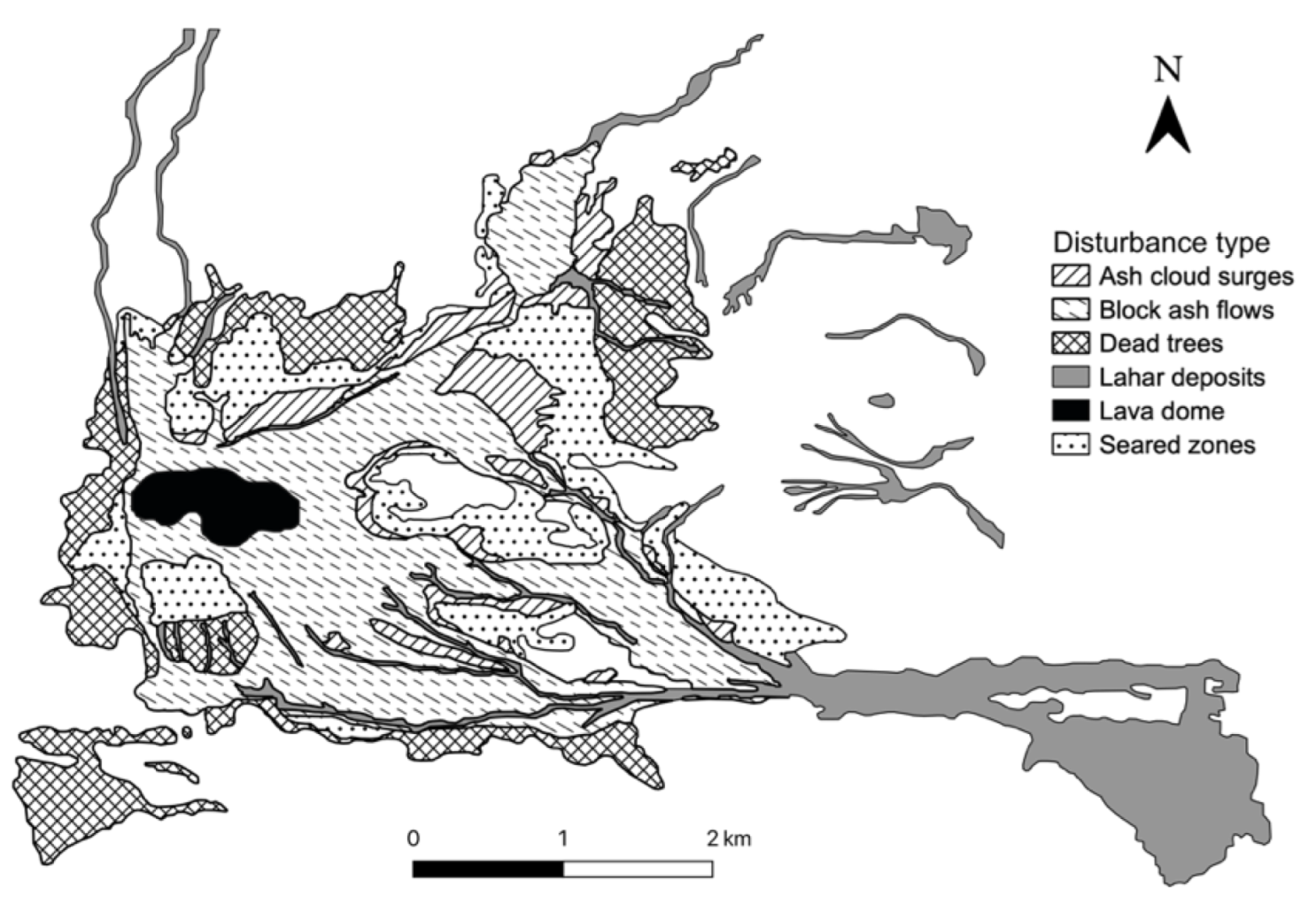
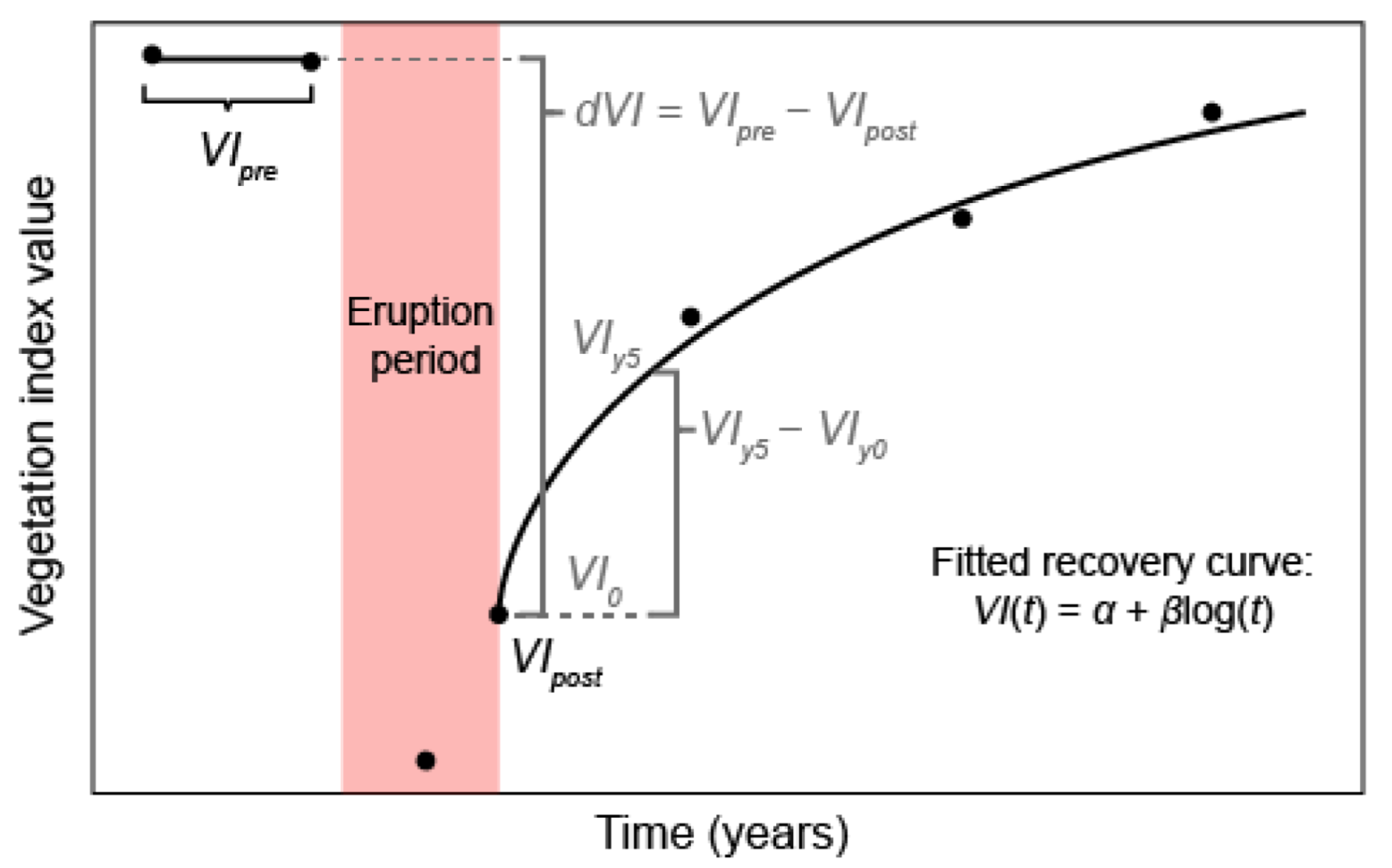
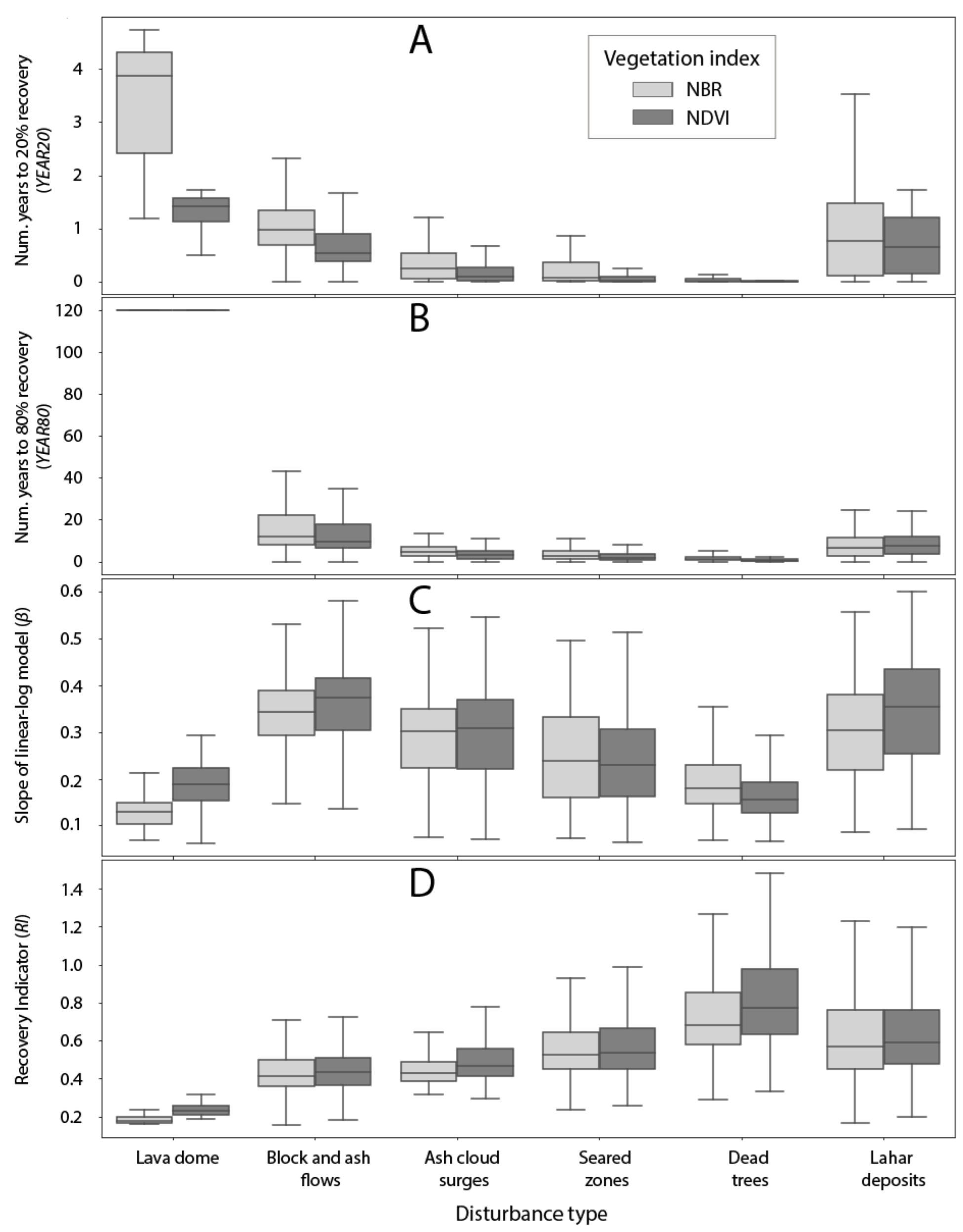
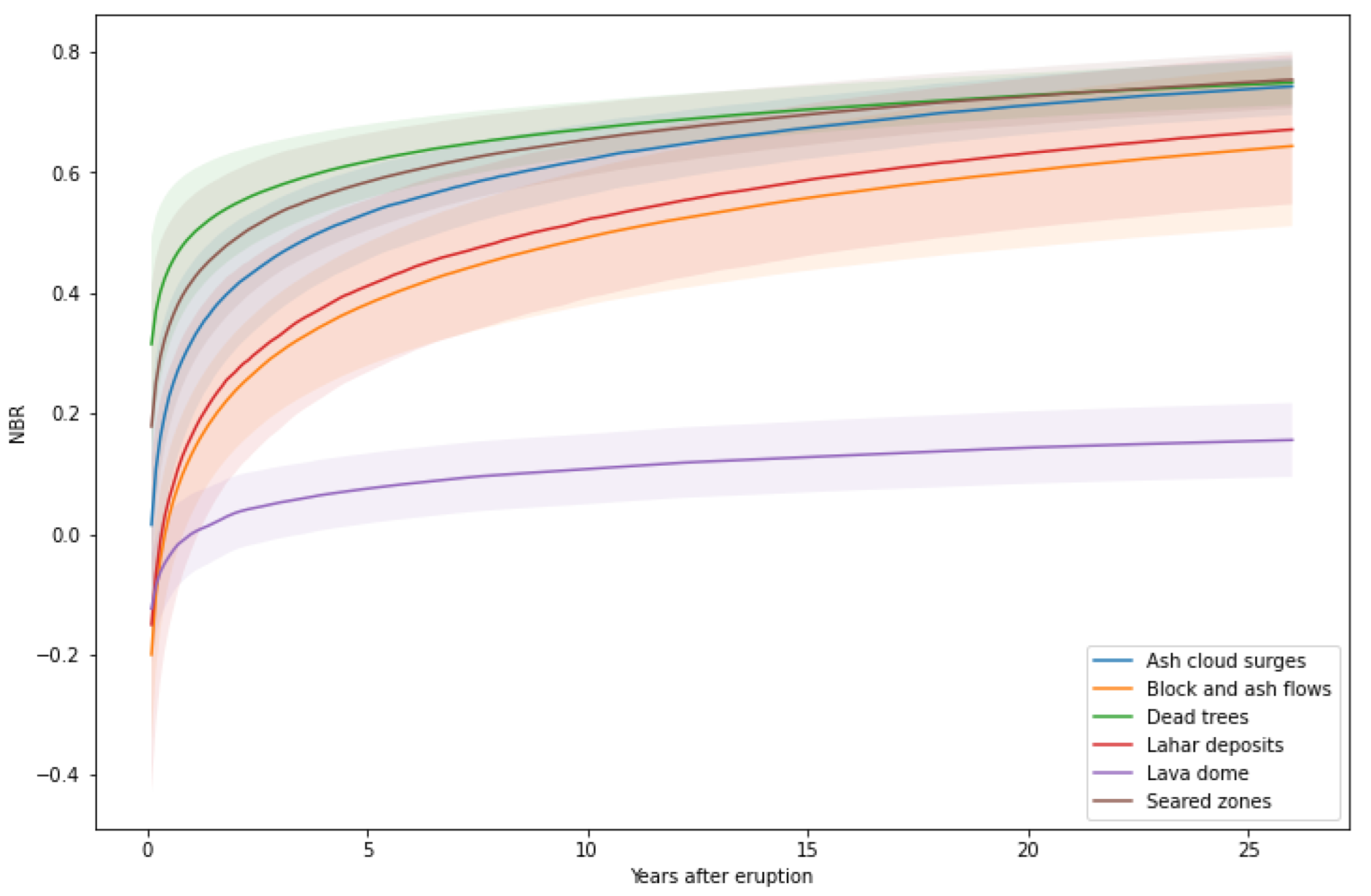
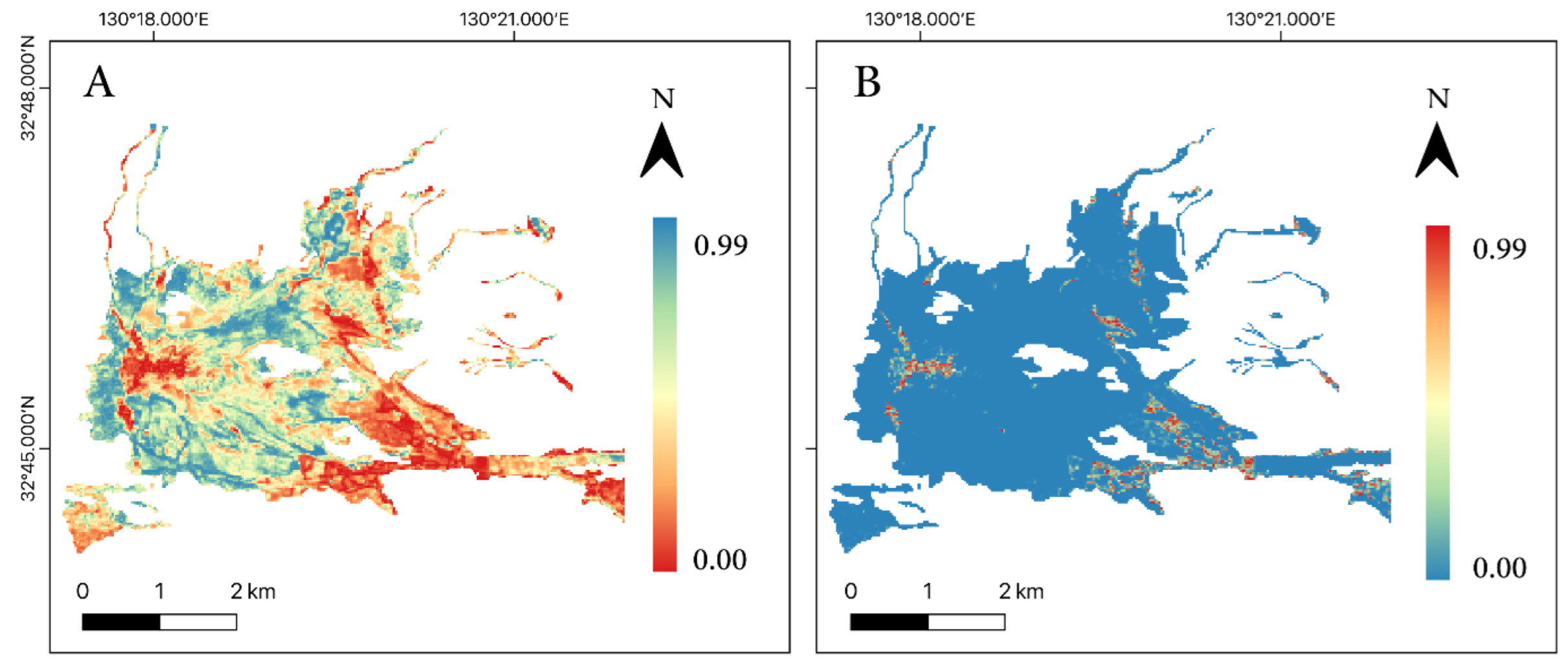
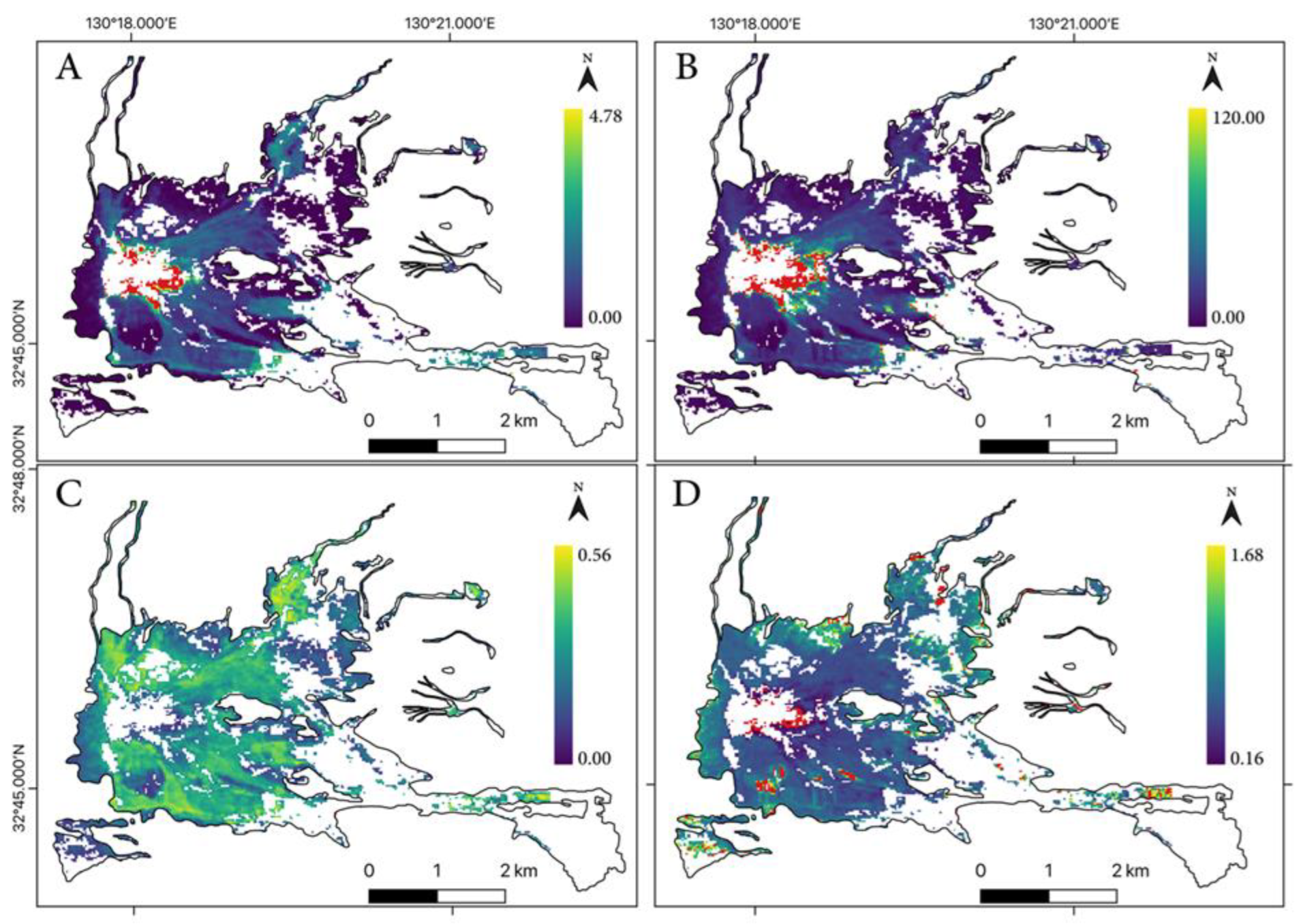
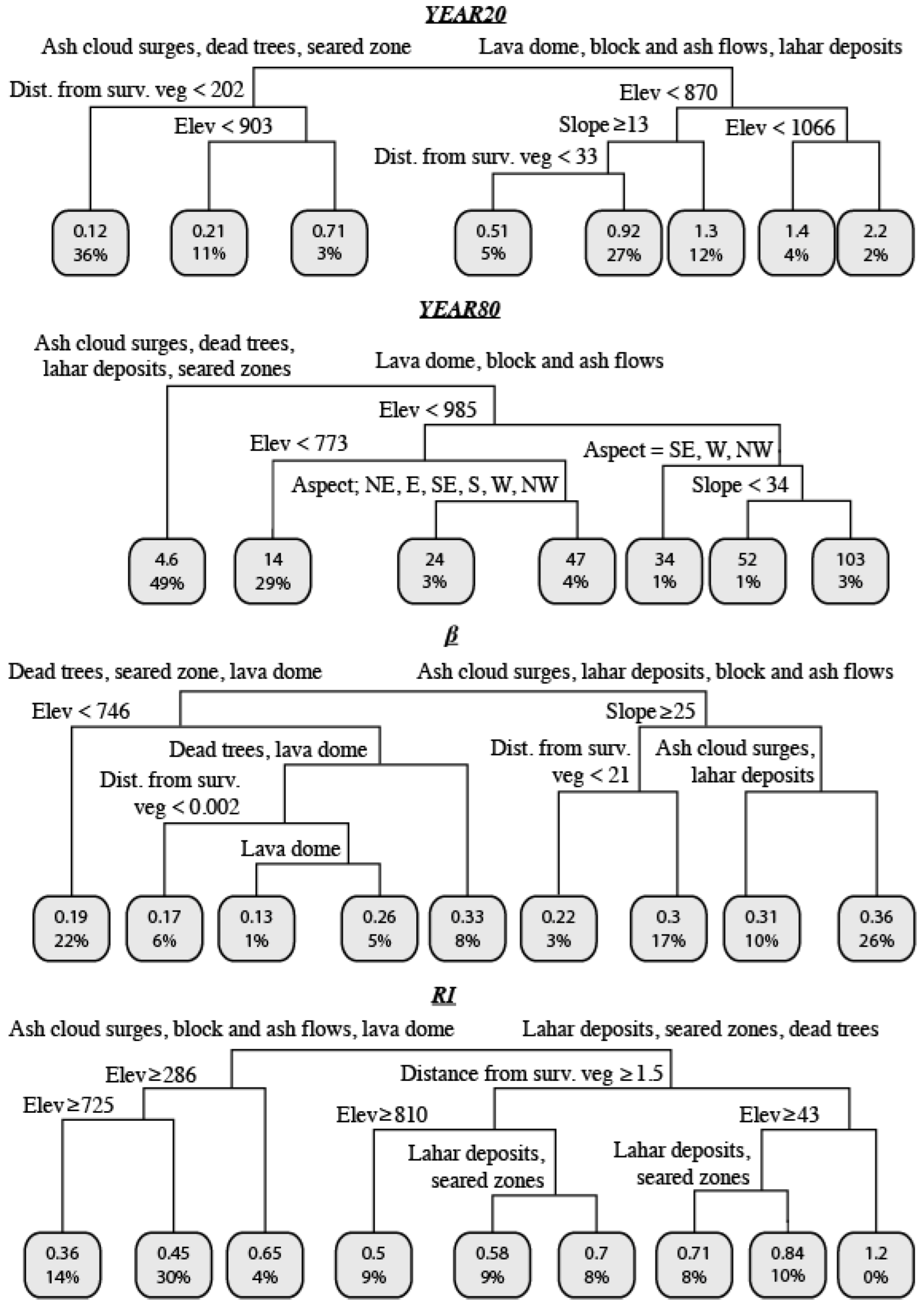
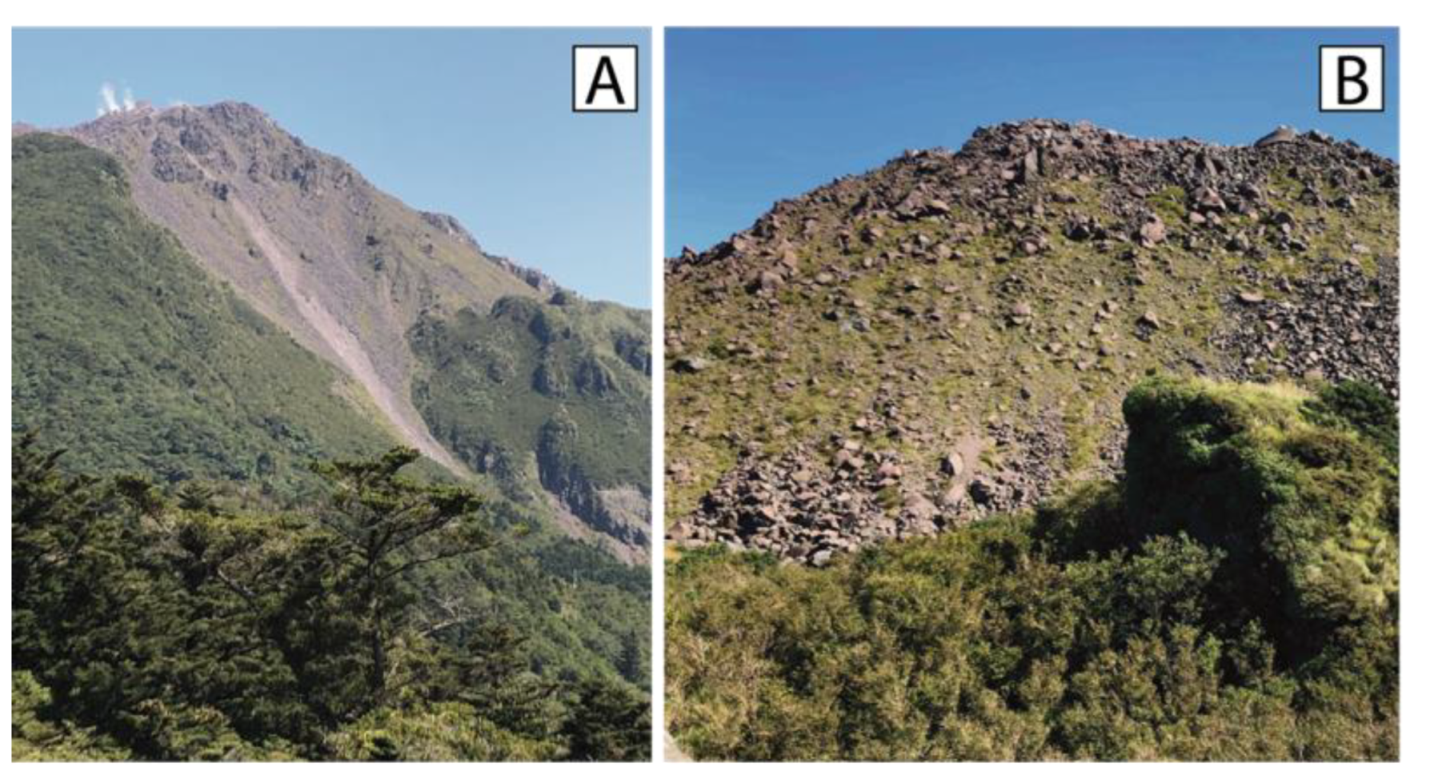
| Lava Dome | Lahar Deposits | Block and Ash Flows | Dead Trees | Ash Cloud Surges | Seared Zones | |
|---|---|---|---|---|---|---|
| YEAR80 | −0.278 | 0.113 | −0.030 | −0.382 | −0.573 | −0.268 |
| YEAR20 | −5.770 | −0.328 | −1.128 | −0.367 | −0.728 | −0.960 |
| β | 1.239 | 0.392 | 0.263 | −0.312 | 0.071 | −0.123 |
| RI | 1.591 | 0.005 | 0.057 | 0.293 | 0.286 | 0.083 |
| Aspect | Slope | Elevation | DC | DF | PC | |
|---|---|---|---|---|---|---|
| Aspect | 1.000 | |||||
| Slope | 0.123 | 1.000 | ||||
| Elevation | 0.084 | 0.656 | 1.000 | |||
| DC | −0.022 | −0.539 | −0.903 | 1.000 | ||
| DF | −0.078 | 0.179 | 0.249 | −0.465 | 1.000 | |
| PC | −0.011 | 0.005 | 0.075 | −0.060 | 0.040 | 1.000 |
| Regression Tree Results | ||||
|---|---|---|---|---|
| YEAR20 | YEAR80 | RI | ||
| r2 | 0.531 | 0.566 | 0.468 | 0.432 |
| Disturbance type | 1 | 1 | 1 | 1 |
| Distance from surviving vegetation | 2 | 2 | ||
| Slope | 2 | |||
| Elevation | 2 | 2 | 2 | 2 |
| Aspect | ||||
| Profile Curvature | ||||
Publisher’s Note: MDPI stays neutral with regard to jurisdictional claims in published maps and institutional affiliations. |
© 2022 by the authors. Licensee MDPI, Basel, Switzerland. This article is an open access article distributed under the terms and conditions of the Creative Commons Attribution (CC BY) license (https://creativecommons.org/licenses/by/4.0/).
Share and Cite
Lai, R.; Oguchi, T.; Zhong, C. Evaluating Spatiotemporal Patterns of Post-Eruption Vegetation Recovery at Unzen Volcano, Japan, from Landsat Time Series. Remote Sens. 2022, 14, 5419. https://doi.org/10.3390/rs14215419
Lai R, Oguchi T, Zhong C. Evaluating Spatiotemporal Patterns of Post-Eruption Vegetation Recovery at Unzen Volcano, Japan, from Landsat Time Series. Remote Sensing. 2022; 14(21):5419. https://doi.org/10.3390/rs14215419
Chicago/Turabian StyleLai, Roxanne, Takashi Oguchi, and Chenxi Zhong. 2022. "Evaluating Spatiotemporal Patterns of Post-Eruption Vegetation Recovery at Unzen Volcano, Japan, from Landsat Time Series" Remote Sensing 14, no. 21: 5419. https://doi.org/10.3390/rs14215419
APA StyleLai, R., Oguchi, T., & Zhong, C. (2022). Evaluating Spatiotemporal Patterns of Post-Eruption Vegetation Recovery at Unzen Volcano, Japan, from Landsat Time Series. Remote Sensing, 14(21), 5419. https://doi.org/10.3390/rs14215419






